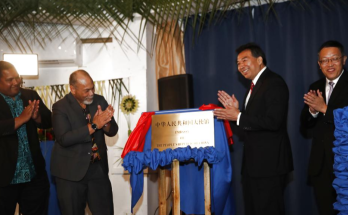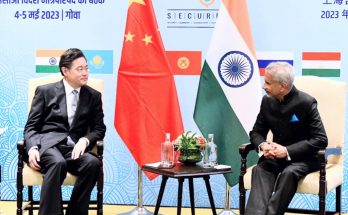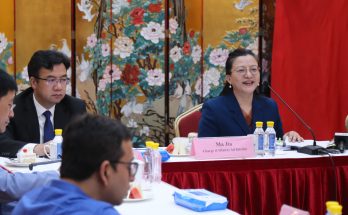 The 18th Special Representatives meeting between India’s National Security Adviser Ajit Doval and his Chinese counterpart, the influential State Councillor Yang Jiechi, in New Delhi on March 23 has a twin agenda. The main purpose of the meeting under this mechanism is to try to find a solution to the long-standing territorial dispute between the two countries, but the focus will be equally on preparing the ground for Prime Minister Narendra Modi’s visit to China in May.
The 18th Special Representatives meeting between India’s National Security Adviser Ajit Doval and his Chinese counterpart, the influential State Councillor Yang Jiechi, in New Delhi on March 23 has a twin agenda. The main purpose of the meeting under this mechanism is to try to find a solution to the long-standing territorial dispute between the two countries, but the focus will be equally on preparing the ground for Prime Minister Narendra Modi’s visit to China in May.
When the Special Representative mechanism was instituted in the wake of Prime Minister Atal Bihari Vajpayee’s visit to Beijing in June 2003, the expectation was that through this mechanism both sides will define first the Line of Actual Control (LAC), paving the way for the final resolution of the territorial dispute.
Three-phase process
Of the three phases of this process, the first phase of knowing each other’s position on the dispute was over by 2005. At the sixth Special Representatives meeting in Beijing, both shifted to the second phase of discussion on an “agreed framework”. The framework was exchanged at the 15th meeting in 2012. At the 18th meeting, both sides intend to explore the third phase. No specific details are provided by both sides, with the spokespersons trotting out the usual clichés about “open, useful, positive, wide-ranging, productive or forward-looking” nature of these talks.
Incursions, and LAC stability
However, several trends recently suggest that the territorial dispute is more intractable than has been imagined in the beginning. The border transgressions at Depsang Plains in April 15-May 6, 2013 or the Chumar troop’s build-up by China in September 2014 – all in the Western Sector of the border – tested the bilateral equations. PM Modi stated, while raising the troop build-up by China, during the visit of President Xi Jinping in September last year that bilateral relations are dependent on the LAC stability.
Out-of-box?
During her visit to Beijing towards January-end this year to attend the 13th Russia-India-China foreign minister’s meeting Sushma Swaraj suggested an “out of the box” resolution to the vexed territorial dispute. She also prodded the Chinese leadership not to leave this issue to the “next generation” as has been the Chinese song since the 2nd border talks enunciated in 1982.
Also, China’s response to PM Modi’s visit to Arunachal Pradesh on February 20 to inaugurate a rail link was sharp and unusual. While PM Manmohan Singh’s visit to Arunachal Pradesh in 2009 was criticised by China, now the level of protest was enhanced to the vice foreign ministerial level. Liu Zhenmin told the summoned India’s Ambassador to China Ashok Kantha on February 21 that Modi’s visit undermined “China’s territorial sovereignty, right and interests”. China had changed its goalposts from the 1950s position of China that McMahon Line (drawn at the Shimla Conference a hundred years ago and at one time Premier Zhou Enlai wanted to recognise) is the disputed line to that of the 2006 position that the “entire area of Arunachal Pradesh is disputed” (i.e. south of the McMahon Line).
Thus, tactfully, the Chinese side had shifted the discourse towards the eastern side of the territorial dispute and refuses, since the first Special Representative meeting, to discuss the Aksai Chin and contiguous areas. Also, China’s military leaders’ visits to Aksai Chin go unnoticed with hardly any criticism from the Indian side.
More significantly, China’s revival of its Kashmir policy and active investments in the dual use infrastructure projects has implications not only to the territorial dispute, but also to the Indian security in the longer run. China’s investments in the Pakistan Occupied Kashmir areas, including the $45 billion outlay on Silk Road announced by China during Prime Minister Nawaz Sharif’s visit to Beijing last year, are of concerns to India.
The Road Ahead: Think Positive
 On the positive note, however, India hosted from February 27- March 2, a Chinese military delegation – to discuss the implementation of the confidence building measures along the borders. The fourth hand-in-hand joint counter-terror operation was also held between the two armies later last year. Also, in an encouraging sign, Foreign Minister Wang Yi stated at a press briefing at the National People’s Congress meeting on March 8 that the border dispute has been “contained”. It needs, however, to be seen whether these positive trends continue on the border areas.
On the positive note, however, India hosted from February 27- March 2, a Chinese military delegation – to discuss the implementation of the confidence building measures along the borders. The fourth hand-in-hand joint counter-terror operation was also held between the two armies later last year. Also, in an encouraging sign, Foreign Minister Wang Yi stated at a press briefing at the National People’s Congress meeting on March 8 that the border dispute has been “contained”. It needs, however, to be seen whether these positive trends continue on the border areas.
The success of the 18th meeting hinges both in arriving at an early and mutually acceptable solution as well as stability in the border areas.
 (Srikanth Kondapalli is Professor in Chinese Studies at Jawaharlal Nehru University, New Delhi. An eminent expert on China and the author of several books on India-China relations, he received the K. Subrahmanyam Award in 2010 for Excellence in Research in Strategic and Security Studies.)
(Srikanth Kondapalli is Professor in Chinese Studies at Jawaharlal Nehru University, New Delhi. An eminent expert on China and the author of several books on India-China relations, he received the K. Subrahmanyam Award in 2010 for Excellence in Research in Strategic and Security Studies.)
–The views expressed in this column are solely those of the author.
Author Profile
Latest entries
 DiplomacyJuly 29, 2019South China Sea Imbroglio: Policy Options
DiplomacyJuly 29, 2019South China Sea Imbroglio: Policy Options China ConnectJuly 28, 2017Rising India & Rising China: A medium-term projection
China ConnectJuly 28, 2017Rising India & Rising China: A medium-term projection DiplomacyDecember 9, 2015PM Abe’s visit: Opening new vistas in India-Japan special ties
DiplomacyDecember 9, 2015PM Abe’s visit: Opening new vistas in India-Japan special ties Africa InsightsDecember 3, 2015A Tale of Two Players in Africa: Indian & Chinese responses
Africa InsightsDecember 3, 2015A Tale of Two Players in Africa: Indian & Chinese responses







